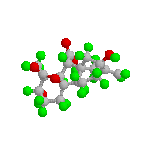|
History of Abscisic Acid
In 1963, abscisic acid was first identified
and characterized by Frederick Addicott and his associates. They
were studying compounds responsible for the abscission of fruits
(cotton). Two compounds were isolated and called abscisin I and
abscisin II. Abscisin II is presently called abscisic acid (ABA)(Addicot,
1963). Two other groups at about the same time discovered the same
compound. One group headed by Philip Wareing was studying bud dormancy
in woody plants. The other group led by Van Steveninck was studying
abscission of flowers and fruits from lupine. Plant physiologists
agreed to call the compound abscisic acid (Salisbury and Ross, 1992).
Biosynthesis and Metabolism
ABA is a naturally occurring compound in
plants. It is a sesquiterpenoid (15-carbon) which is partially produced
via the mevalonic pathway in chloroplasts and other plastids. Because
it is sythesized partially in the chloroplasts, it makes sense that
biosynthesis primarily occurs in the leaves. The production of ABA
is accentuated by stresses such as water loss and freezing temperatures.
It is believed that biosynthesis occurs indirectly through the production
of carotenoids. Carotenoids are pigments produced by the chloroplast
which have 40 carbons. Breakdown of these carotenoids occurs by
the following mechanism:
Violaxanthin is a carotenoid which has forty carbons.
It is isomerized and then split via an isomerase reaction followed
by an oxidation reaction.
One molecule of xanthonin is produced from one molecule of violaxanthonin
and it is uncertain what happens to the remaining biproduct.
The one molecule of xanthonin produced is unstable and spontaneously
changed to ABA aldehyde.
Further oxidation results in ABA.
Activation of the molecule can occur by two methods. In the first
method, an ABA-glucose ester can form by attachment of glucose to
ABA. In the second method, oxidation of ABA can occur to form phaseic
acid and dihyhdrophaseic acid.
The transport of ABA can occur in both xylem and phloem tissues.
It can also be translocated through paranchyma cells. The movement
of abscisic acid in plants does not exhibit polarity like auxins.
ABA is capable of moving both up and down the stem (Walton and Li,
1995; Salisbury and Ross).
Functions of Abscisic Acid
The following are some of the phyysiological
responses known to be associated with abscisic acid (Davies, 1995;
Mauseth, 1991; Raven, 1992; Salisbury and Ross, 1992).
- Stimulates the closure
of stomata (water stress brings about an increase in ABA synthesis).
- Inhibits shoot growth
but will not have as much affect on roots or may even promote
growth of roots.
- Induces seeds to synthesize
storage proteins.
- Inhibits the affect
of gibberellins on stimulating de novo synthesis of a-amylase.
- Has some effect on
induction and maintanance of dormancy.
- Induces gene transcription
especially for proteinase inhibitors in response to wounding which
may explain an apparent role in pathogen defense.
|



